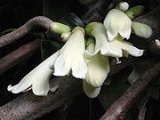
Tecomanthe
Encyclopedia
Tecomanthe is a genus
of 5 species
of tropical or subtropical forest lianes in the family Bignoniaceae
. They have attractive trumpet-like flowers and glossy leaves. They are native to Australia
, Indonesia
, New Guinea
, New Zealand
, and the Solomon Islands
.
Genus
In biology, a genus is a low-level taxonomic rank used in the biological classification of living and fossil organisms, which is an example of definition by genus and differentia...
of 5 species
Species
In biology, a species is one of the basic units of biological classification and a taxonomic rank. A species is often defined as a group of organisms capable of interbreeding and producing fertile offspring. While in many cases this definition is adequate, more precise or differing measures are...
of tropical or subtropical forest lianes in the family Bignoniaceae
Bignoniaceae
The Bignoniaceae, or Trumpet Creeper Family, is a family of flowering plants comprising about 650-750 species in 116-120 genera. Members of the family are mostly trees and lianas , shrubs and more rarely herbaceous plants. As climber plants, they are twine climbers or tendril climbers, and rarely...
. They have attractive trumpet-like flowers and glossy leaves. They are native to Australia
Australia
Australia , officially the Commonwealth of Australia, is a country in the Southern Hemisphere comprising the mainland of the Australian continent, the island of Tasmania, and numerous smaller islands in the Indian and Pacific Oceans. It is the world's sixth-largest country by total area...
, Indonesia
Indonesia
Indonesia , officially the Republic of Indonesia , is a country in Southeast Asia and Oceania. Indonesia is an archipelago comprising approximately 13,000 islands. It has 33 provinces with over 238 million people, and is the world's fourth most populous country. Indonesia is a republic, with an...
, New Guinea
New Guinea
New Guinea is the world's second largest island, after Greenland, covering a land area of 786,000 km2. Located in the southwest Pacific Ocean, it lies geographically to the east of the Malay Archipelago, with which it is sometimes included as part of a greater Indo-Australian Archipelago...
, New Zealand
New Zealand
New Zealand is an island country in the south-western Pacific Ocean comprising two main landmasses and numerous smaller islands. The country is situated some east of Australia across the Tasman Sea, and roughly south of the Pacific island nations of New Caledonia, Fiji, and Tonga...
, and the Solomon Islands
Solomon Islands
Solomon Islands is a sovereign state in Oceania, east of Papua New Guinea, consisting of nearly one thousand islands. It covers a land mass of . The capital, Honiara, is located on the island of Guadalcanal...
.
Species
- Tecomanthe dendrophylla (or T. venusta) grows in the Moluccas, throughout New GuineaNew GuineaNew Guinea is the world's second largest island, after Greenland, covering a land area of 786,000 km2. Located in the southwest Pacific Ocean, it lies geographically to the east of the Malay Archipelago, with which it is sometimes included as part of a greater Indo-Australian Archipelago...
, and east into New BritainNew BritainNew Britain, or Niu Briten, is the largest island in the Bismarck Archipelago of Papua New Guinea. It is separated from the island of New Guinea by the Dampier and Vitiaz Straits and from New Ireland by St. George's Channel...
and the Solomon IslandsSolomon IslandsSolomon Islands is a sovereign state in Oceania, east of Papua New Guinea, consisting of nearly one thousand islands. It covers a land mass of . The capital, Honiara, is located on the island of Guadalcanal...
. The 11cm flowers are pink and creamy-yellow, ageing to a uniform magenta-pink. - Tecomanthe hillii with pink flowers is confined to eastern QueenslandQueenslandQueensland is a state of Australia, occupying the north-eastern section of the mainland continent. It is bordered by the Northern Territory, South Australia and New South Wales to the west, south-west and south respectively. To the east, Queensland is bordered by the Coral Sea and Pacific Ocean...
. - Tecomanthe speciosaTecomanthe speciosaA solitary plant of Tecomanthe speciosa or the Three Kings Vine was first discovered on the Three Kings Islands, 55 km off the northern tip of New Zealand, during a scientific survey in 1945. No other specimens have ever been found in the wild. Tecomanthe is a tropical genus not otherwise...
is endemic to the Three Kings IslandsThree Kings IslandsThe Three Kings Islands or Manawa Islands are a group of 13 islands about northwest of Cape Reinga, the northernmost point of the North Island of New Zealand, where the South Pacific Ocean and Tasman Sea converge. They measure about 4.86 km² in area...
off northern New ZealandNew ZealandNew Zealand is an island country in the south-western Pacific Ocean comprising two main landmasses and numerous smaller islands. The country is situated some east of Australia across the Tasman Sea, and roughly south of the Pacific island nations of New Caledonia, Fiji, and Tonga...
. Only one plant exists in the wild, T. speciosa is now in cultivation, and is a rampant woody vine with cream flowers. It will grow in warm temperate climates, but is very sensitive to frost. - Tecomanthe ternatensis has white flowers that turn pink as they age. Its natural range is from the Moluccas east to northwest New GuineaNew GuineaNew Guinea is the world's second largest island, after Greenland, covering a land area of 786,000 km2. Located in the southwest Pacific Ocean, it lies geographically to the east of the Malay Archipelago, with which it is sometimes included as part of a greater Indo-Australian Archipelago...
. - Tecomanthe volubilis is endemic to New Guinea and has rose-pink flowers. It grows in mossy forests at altitude, and will grow in warm temperate conditions.

